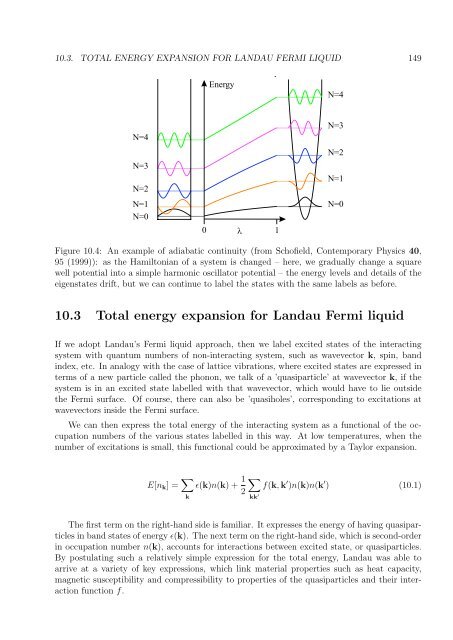Set of supplementary notes.
Set of supplementary notes.
Set of supplementary notes.
You also want an ePaper? Increase the reach of your titles
YUMPU automatically turns print PDFs into web optimized ePapers that Google loves.
10.3. TOTAL ENERGY EXPANSION FOR LANDAU FERMI LIQUID 149<br />
Energy<br />
N=4<br />
N=4<br />
N=3<br />
N=2<br />
N=1<br />
N=0<br />
0 1 <br />
N=3<br />
N=2<br />
N=1<br />
N=0<br />
Figure 10.4: An example <strong>of</strong> adiabatic continuity (from Sch<strong>of</strong>ield, Contemporary Physics 40,<br />
95 (1999)): as the Hamiltonian <strong>of</strong> a system is changed – here, we gradually change a square<br />
well potential into a simple harmonic oscillator potential – the energy levels and details <strong>of</strong> the<br />
eigenstates drift, but we can continue to label the states with the same labels as before.<br />
10.3 Total energy expansion for Landau Fermi liquid<br />
If we adopt Landau’s Fermi liquid approach, then we label excited states <strong>of</strong> the interacting<br />
system with quantum numbers <strong>of</strong> non-interacting system, such as wavevector k, spin, band<br />
index, etc. In analogy with the case <strong>of</strong> lattice vibrations, where excited states are expressed in<br />
terms <strong>of</strong> a new particle called the phonon, we talk <strong>of</strong> a ’quasiparticle’ at wavevector k, if the<br />
system is in an excited state labelled with that wavevector, which would have to lie outside<br />
the Fermi surface. Of course, there can also be ’quasiholes’, corresponding to excitations at<br />
wavevectors inside the Fermi surface.<br />
We can then express the total energy <strong>of</strong> the interacting system as a functional <strong>of</strong> the occupation<br />
numbers <strong>of</strong> the various states labelled in this way. At low temperatures, when the<br />
number <strong>of</strong> excitations is small, this functional could be approximated by a Taylor expansion.<br />
E[n k ] = ∑ k<br />
ɛ(k)n(k) + 1 2<br />
∑<br />
kk ′ f(k, k ′ )n(k)n(k ′ ) (10.1)<br />
The first term on the right-hand side is familiar. It expresses the energy <strong>of</strong> having quasiparticles<br />
in band states <strong>of</strong> energy ɛ(k). The next term on the right-hand side, which is second-order<br />
in occupation number n(k), accounts for interactions between excited state, or quasiparticles.<br />
By postulating such a relatively simple expression for the total energy, Landau was able to<br />
arrive at a variety <strong>of</strong> key expressions, which link material properties such as heat capacity,<br />
magnetic susceptibility and compressibility to properties <strong>of</strong> the quasiparticles and their interaction<br />
function f.








